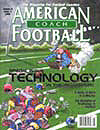AMERICAN FOOTBALL MONTHLY THE #1 RESOURCE FOR FOOTBALL COACHES
Article CategoriesAFM Magazine
|
Success is Coming in Bunches at WisconsinSuccess Is Coming In Bunches At Wisconsin.by: Timothy Nott © More from this issue According to the Acromania Index on the Ziff Davis website www.zdnet.com, Information Technology is defined Pronounced as separate letters, IT refers to the broad subject of managing and processing information. In contrast, Vince Lombardi noted, "football is only two things - blocking and tackling." How can one reconcile the differences between the general study and application of data and this strict, physical discipline? Barry Alvarez and company at the University of Wisconsin have been working on the equation for the past decade. An initial technology investment in video has slowly grown to incorporate additional aspects of the program. In the past four years alone, recruiting, public relations, fundraising, gameplans, play analysis, scouting and video editing have all come to rely on technology. Not all of the technolog....The full article can only be seen by subscribers.
|
|
|||||||
| HOME |
MAGAZINE |
SUBSCRIBE | ONLINE COLUMNISTS | COACHING VIDEOS |
Copyright 2025, AmericanFootballMonthly.com
All Rights Reserved





